
11. Data Menu
Selecting Data gives you access to much of the historical database.

Selecting Track allows you to choose which track data you wish to view. Once you are looking at a track, you may view courses, kennels, dogs, grades and more within that track.
Configuration allows you to work with how DogBase runs its analysis and makes its recommendations. Combined with the track history, this allows you to try different ideas and see how it plays out in the past before placing wagers on the future.
The Filters option is used to view and define race filters. Race filters are used to exclude races that match a certain criteria from a configuration, wager, etc. In its simplest form to separate the evening and afternoon races.
Selecting Dogs shows you information on an individual dog regardless of the track. Remember you can see the same information on only those dogs at a specific track by choosing track and kennel first.
Comments are downloaded and stored by the system. You may wish to review the comments on the screen and make any corrections. This process would allow you to do so.
Comment Keywords is how the computer knows to pre-mark its comments in the import. If a Keyword is found the computer will mark the comment accordingly.
The License Screen is already familiar to you. It is the screen you used to activate the program in Registering your Copy of DogBase. It is available here so you can change or view your license info.
The power behind the DogBase program is the historical database. Stored data is available to you to view and modify (when available). When displaying data, several buttons appear on almost every screen. There are two groups of buttons: arrows and function names. The first group is the arrow buttons seen here:
![]() = First,
= First,
![]() = Prior,
= Prior, ![]() = Next and
= Next and ![]() = Last
= Last
These four buttons allow you to move from one record to another within the database. For instance, if you were looking at Dog Data, the up arrow pointing to a line would display the first record in the Dog Data file. The up arrow without a line would display the prior Dog. The Down arrow pointing to a line would display the last Dog in the file. The down arrow without a line would display the next Dog.
The next set of buttons are:
![]()
The search button is a more advanced version of the arrows seen above. The arrow buttons are helpful, when you may not know the Track, Kennel, etc.. The search button is helpful here in that it displays a list allowing you to choose.
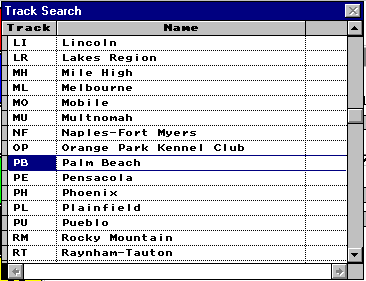
As you scan the list provided by the search button and find the Track you wish to display, point and click the left mouse button on that dog. This tells the computer which to display. Then press the right mouse button. This tells the computer to display the selected item.
![]()
The Exit button is provided to close the current window and return you to the prior one.
![]()
If you make changes to data on the screen and press the Cancel button, those changes will be replaced with the original data.
You may see other buttons along with the above three such as Add, Copy and Delete. These will be defined when used. You may see still more buttons to display information within the data you are viewing. For instance, if you are looking at a Kennel record and choose the Dogs button you may see the Dogs within that Kennel.
DogBase was sent with most tracks already defined. However, there may be a need to modify track data occasionally. The track definition is available to you by selecting Data and then clicking Track.
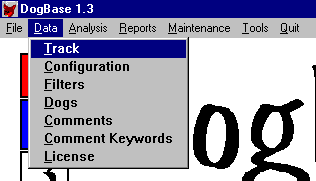
Once a track is selected, the computer will respond with a window similar to the following. You may look at performances, kennels, courses and course identifiers within that track. Within these selections other possible data displays are available.
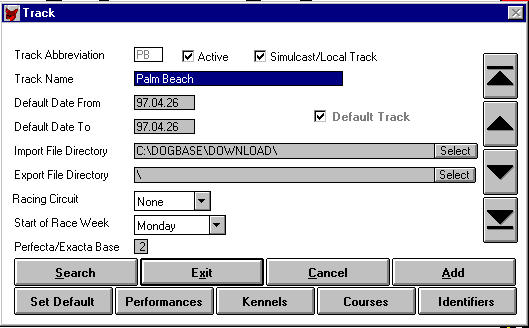
Of the fields displayed, only the Track Abbreviation (or Track ID) may not be changed.
The Active checkbox is used to activate or inactivate a Track. It is important to activate tracks you are using.
The Simulcast/Local Track checkbox is not used at this time.
The Track Name field is obvious and needs no explanation.
The Default Dates: From and To are used during Analysis and Reports described in a later section of this document. These are the date ranges used during those procedures. When working with a track, the values of these fields are retained as the default, making your experimentation with grade and wager configurations consistent as well as easy. These dates may be changed in those procedures, but setting them here may make DogBase easier to use. Also, remember these dates must be in Year, Month and Day (YY.MM.DD) order on the screen.
The Import File Directory must be set before importing data into DogBase. The Import File Directory is where your communications software or web-browser saved the data files you downloaded.
The Export Directory is used if you purchased the additional export feature for DogBase. This allows you to export DogBase data into a popular format in the directory specified.
Racing Circuit is currently just an information field it is not used in the program.
Start of Race Week (or start of purse week) is used in the Race Day reports Kennel list to determine the Kennels recent record.
Perfecta/Exacta Base is the minimum cost of a perfecta bet for the track.
Add Button
The Add button displays the following screen:
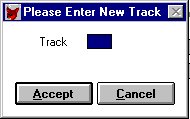
Fill in the two character Track ID and press the Accept key (cancel aborts the Add). Once accepted the computer will display a standard track maintenance screen similar to the one defined previously in this document.
*Note, once the accept button is pressed, you must complete the add and there is no delete option for tracks…be careful.
When you choose performances from a track the following screen will be displayed with the most recent performance (past or future) displayed. This screen does not allow you to make changes. The search and arrow buttons allow you to view other performances at the track. The Races button allows you to view the data on a specific race in more detail.
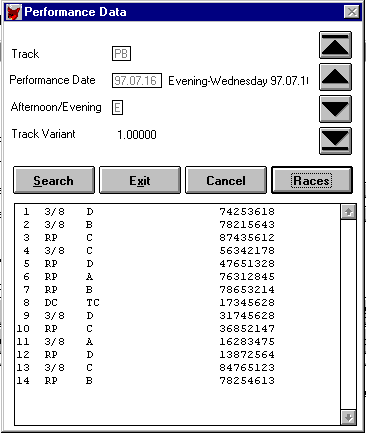
The top of the screen tells you the track and performance you are viewing, along with the track variant (created by Import data described in an earlier section). The lists at the bottom of the screen are columns of data showing the race number for the performance in the 1st column. Following the race number are the course and grade of the race. The next column is A.O.O.F. (Actual Order of Finish) which, in this case, is blank. This means the race entries/program (future race) was downloaded and imported, but the results from the race have not yet been imported. The next column is P.O.O.F. (Projected Order of Finish) which is the last column you see in our example.
When you push the races button within a performance, the following screen is displayed. Again, this display is information only.
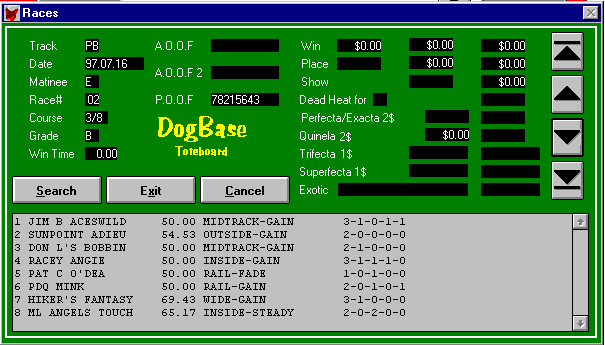
The list on the bottom of this screen shows the entries and results of the race.
The kennels option within a track displays data and also allows you to change the kennel name or abbreviation.
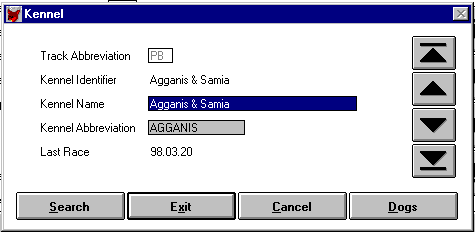
Additionally, you may display dogs within the kennel. When looking at the dogs in a kennel, a screen similar to the following is displayed. Although this is intended as an informational screen, you may change the Sire, Bitch, Whelp Date, Sex and Color.
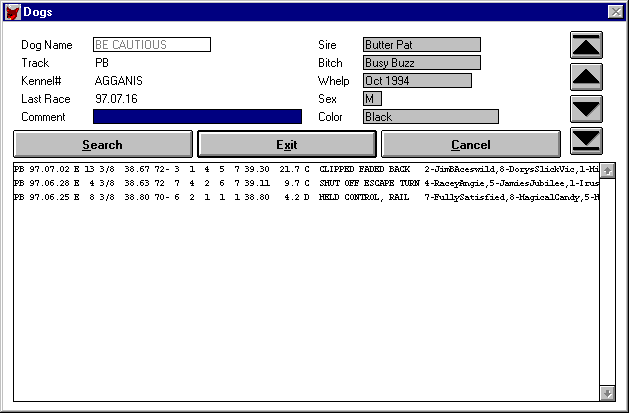
Please note that if you change a Kennel Abbreviation, you may not see dogs for that kennel until the kennel information is updated for each dog. Please be careful.
Choosing the Course Button from the Track screen will show you the different courses for the track. You may change the Course Name, Distance and Record, all of which are informational only. The one field needing explanation here is the Export Course. This is used by the Export function (licensed separately) to output DogBase data in a popular format. This field is necessary due to the fact DogBase uses a more descriptive four character Course ID while programs importing the data that DogBase exports use a one character Course.
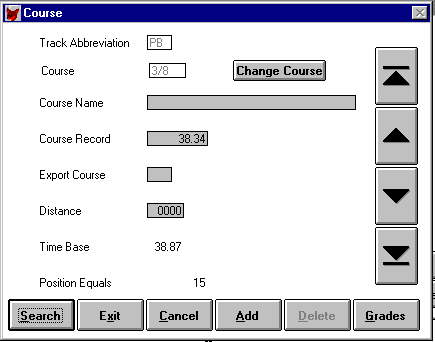
Adding a Course
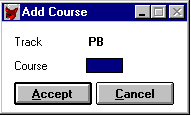
The Grades within a Course display tells the computer about the grade and how to handle it for the Track and Course. Fields you may change are: Description, Grade Equals, Box Bias and Style Bias. The following fields are important in how DogBase forms its analysis and predictions.
Grade Equals is used by the system and is defined in Things to Know Before Beginning.
The Box Bias Minimum is the minimum attempts in that box for a dog before it uses the box bias settings in the configuration. The Maximum is the limit of the most recent races in that box to use. In this example you must have at least 20 races in a box before using the bias, then the computer will use up to the last 100 races for that box.
Style Bias is similar to the Box Bias except it looks at information like how an inside fader does in the "2" box and etc..
The Override Rating allows you to setup your own grade point system instead of using the one calculated by DogBase AKA the DogBase Rating. Please not that if you override one grade for a course I recommend you override them all. The reason for this is when you run a refresh it will change the DogBase ratings for the other grades while your override rating hasn't changed.

Add Grade

When you have found profitable bets for a grade, you may want to enter them into the Bets within Grade for Track's Course.
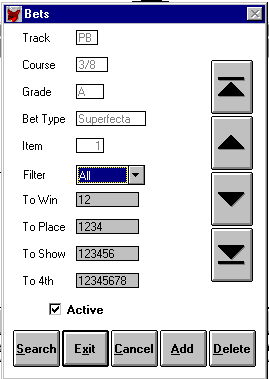
This file is used in the Race Day reports to generate the optional Bets Report and in the Profit Statement (both of which are defined later in this document). You may set the "To Win", "To Place", "To Show", "To 4th". When the computer makes its determination of the finish, it will rank the dogs 1 through 8. If "To Win" is 123, the first three dogs in the computer's pick will be placed on the race day bet report , wager and profit statement reports. If "To Place" is set to 234, the computer will put the dogs it forecast as second, third and fourth in the reports. This model works through the fourth position. The Active flag is used in the Profit Statement report and the Raceday Bet Report to determine what bets to run or print. More than one record may be in the file for the Track, Course, Grade, Bet combination and more than one may be active. The active ones will be used in the profit report for verifying your "theories".
Note: Putting an '*' in To Win, To Place, To Show or To Fourth fields will be replaced with the numbers 1 thru 8.
Add a Bet
As the opening paragraphs to Bets within a Track, Course and Grade stated, you may have more than one record. Each is uniquely identified by the item number (assigned by the computer when the bet was added). Pressing the Add button displays the following screen
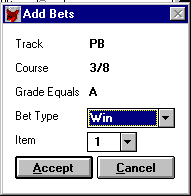
To add, first choose the Bet Type and press Accept. Cancel aborts the add. Once an accept button on the add is pressed, you must finish the add. After the accept is clicked, a standard maintenance screen (like the first screen in this section) will be displayed allowing you to finish your add.
To delete bet press the Delete button. Once the following screen is displayed pressing the Yes button deletes the record. Press No if you do not want to delete a record. BE CAREFUL deletes are permanent.
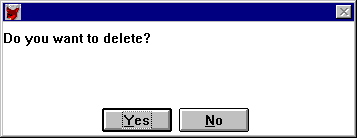
Configurations
Configuration within Grade is just a different way of accessing your configuration data. See Configurations for a further description of these screens.
Course Identifiers are how dogbase converts the courses used by the different import services into the courses you have defined in your system. This file is setup in the import data procedure and if done correctly then should never have to changed. This option however allows you do so.
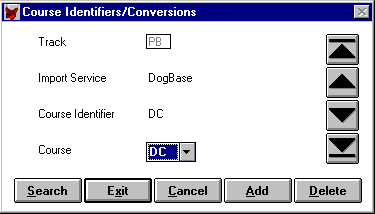
The Import Service field is the type of the file. In this case it is a file created in DogBase Entry/Edit Data. The Course Identifier is the course used by the Import Service and the Course field is the Course you have previously defined in DogBase.
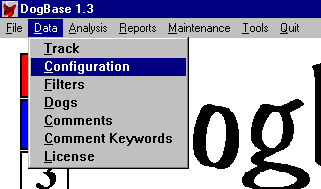
Configurations are the life blood of the DogBase program and your direct link to controlling its forecasts. A configuration sets the rules on how DogBase makes its forecasts, using either historical data to test your theories or making forecasts for race day reports. When a New Grade is added, a default configuration is set up as item 1. This default is a very basic configuration that seems to work well at most grades, but it is far from tuned to each individual grade.
There may be more than one configuration record for each track, course and grade. Each may be set active or inactive. Inactive configurations are not used by Raceday Reports or Run All Configs-Grade. The #1 configuration for any grade cannot be inactive or have a Filter other than 'All'.It also cannot be deleted. This is because it is default configuration used if no other configurations are active with a higher priority than the #1 config. This insures the computer will always have a valid configuration for a grade.
For Raceday reports the computer will use the highest priority configuration with a valid filter. This allows you to have a differnt configuration for different races. Again in its simplest form for separating Afternoon and Evening races.
The most important section of the screen below is the Class Section. This determines how the base value of each dog is calculated. Every other section simply modifies the value created from Class. Find the best way to calculate class first, then modify the other fields to fine tune your configuration. See field descriptions below for a description of each field and what they do.

Name-Your Description of the Configuration
Filter-This is the race filter that the configuration is using. Filters are defined later in this chapter.
Priority-This is the configurations priority value. The configuration with the highest priority and a valid Filter will be used for Raceday Reports. Note setting a configs priority to zero will in effect make it inactive. Since its priority will always be lower than the #1 Config.
Active-Determines whether to use this Config in Raceday Reports.
Class Section
Class By-This is the method of determining the class value. The values and a brief description follow:
|
Class By
|
Description
|
| Position+Time | Positions Back + Time Value |
| Position+Grade | Positions Back + Grade Value |
| Length+Time | Lengths Back + Time Value |
| Length+Grade | Lengths Back + Grade Value |
| Variant+Time | Lengths back from Variant Time + Time Value |
| Variant+Grade | Lengths back from Variant Time + Grade Value |
| Variant+RaceGrade | Lengths back from Race Grade Variant + Time Value |
| Minimum | Gives each dog a class value of 2 times the Minimum Value. This give each dog the same class value. |
Minimum-The Minimum class value a dog can have.
Min Count-The minimum number of races required to assign a value other than the minimum.
Max Count-Defines the Maximum number of races to look back to determine the class value.
Max Days-Defines the maximum number of days to look back to determine the class value.
Clean Only-This determines whether or not to use Trouble races in the class value.
Use Schools-This tells the computer whether to use schooling races in its calculations.
Categories Section
Categories are used by the computer to look at how a dog performs in specific circumstances. For example: how does a dog do in this grade or in this box. It then sorts the categories to determine the best one.
Best By-This field determines how to sort the categories. Your choices include: Time, 1stCall, Finish and Combined.
The Categories are as follows:
Overall uses all races except those excluded by the field values.
Box uses only races from that box and the two adjoining boxes.
Grade uses races from the current grade only.
Money uses only races where the dog has finished in the money.
Early uses only races where the dog was 1st, 2nd or 3rd at the first call.
Last 3 uses only the last three races that meet the field's criteria.
Last 2 is the same as Last 3 except it only uses the last two races.
Each category has four fields associated with it. They are: Min Count, Max Days, Bonus and Clean Only.
Min Count is the minimum number of races required to use this category. Note, setting a value to zero disables that category.
Max Days is the maximum number of days to look back.
Bonus is used if this category is the dog’s best, the bonus is then added to that dog’s power value.
Clean Only tells the computer whether or not to count trouble races for that category.
Power Modifiers Section
Bias By-Tells the computer whether to apply a Box Bias or Style Bias to the Power Value. The different options are as follows: None, no box bias is used, Box, apply the standard box bias to the power value and Style, use the style bias values to modify power.
Bias Points-The base value multiplied by the bias value to determine what to apply to the power value. Note: Zero in Bias Points will use the dog's class value for the base.
Time Bonus-Used to reward dogs with better best times. For example a dog with a best time of 30.90 would be awarded more points than a dog with a best time of 31.20. In this example a Time bonus of 50 would result in about an 8 point advantage. Typical values for this field are between 25-150.
Time Bonus Box-
Time Bonus Grade-
Gain Bonus-For rewarding closing ability. The value entered is multiplied by the dog’s average gain and added to power.
Effort Bonus-Rewards dogs that gave a good effort in his last 2 races.
Break Bonus-Added to the dog's power value if it ranks among the top three breakers in the race.
1st & Break-Added if the dog ranks in the top three in both Break and 1st Call.
Points System Section
Break (1st-9th)-These fields are used to award points by computer ranked position. For example a value of 10 in the 1st Field in the Break Column would give the dog with the 1st ranked break figure an additional 10 points. The 8th field with a value of (-5), would take 5 points away from the 8th ranked dog and so forth.
Break Bias-Tells the computer whether to apply a Box Bias or Style Bias to the Break Rankings.
1st Call (1st-9th)-These fields work the same as above except from the 1st call ranking.
1st Bias-Tells the computer whether to apply a Box Bias or Style Bias to the 1st Call Rankings.
2nd Call (1st-9th)-Same as above except from the 2nd Call Ranking.
2nd Bias-Tells the computer whether to apply a Box Bias or Style Bias to the 2nd Call Rankings.
Finish (1st-9th)-Same as above except from the finish Ranking.
Finish Bias-Tells the computer whether to apply a Box Bias or Style Bias to the Finish Rankings.
Time (1st-9th)-Same as above except from the Time Ranking.
1st-Fin (1st-9th)-Same as above except the ranking is determined by the gain from the 1st call to the finish.
Break-1st (1st-9th)-Same as above except the ranking is determined by the gain from the Break to the 1st Call.
1st-2nd (1st-9th)-Same as above except the ranking is determined by the gain from the 1st call to the 2nd Call.
2nd-Fin (1st-9th)-Same as above except the ranking is determined by the gain from the 2nd call to the finish.
Once a configuration is set up, you may test it against the historical data you have built from your downloads and imports. You do this by pressin the Run button. It will then bring up a window asking for what dates you want to run the configuration against.

The default dates entered in the track file will come up on the screen. You can use the default or enter your own dates. Press Continue after you have the correct dates on the screen.
The Filters option is used to define race filters for configurations, wagers and bets. Race filters are used to by these programs to separate different race types from one another. This gives DogBase the ability to handicap races differently based on the race. As of this writing the filters that come already setup with DogBase are All, AFTERNOON and EVENING. These allow you to handicap afternoon races differently from evening races. You may add as many filters as you want to DogBase within the fields provided on the filter screen..
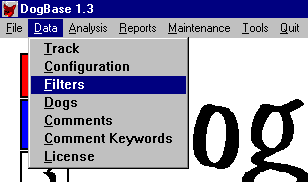
After selecting the Filters option the following screen will be displayed.

The Performance Type field allows you to specify whether you want All, AFTERNOON, EVENING or LATE NITE performances.
Race number range allow you to filter out races outside the range of race numbers.
Days of Week let you select what days of the week you want to filter for.
The Dog Data screens allow you to scan the historical information on all dogs (versus only the dogs in a specific kennel as noted earlier in this chapter).

When you display data on a dog, its races in the DogBase database will be displayed below the dog’s demographic data, Track ID and Kennel Abbreviation. Below is a dog data window. All fields related to the dog are displayed. You may change Sire, Bitch, Whelp, Sex and Color as well as set the Kennel for the dog. Most of these fields are informational only as the computer does not base its picks on them. The Kennel is important because it allows you to see the dogs within a kennel from the Kennel data screen. The dog data window has a button to show just the dogs in that kennel.
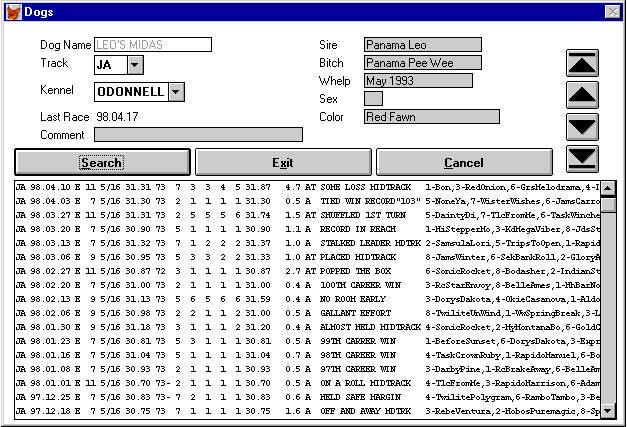
Comment data is very important for the analysis and reports within DogBase. It is here that you give information which DogBase uses for forecasting. This information is usually set up in the download/import and not touched thereafter. Clicking Data and then Comments allows you display and possibly modify comment data.

Once selected, the first comment in the file is displayed. There are two groups of fields that are important here: Location and Trouble.
The location group allows you to choose one of the selections only. Your choices include Rail, Inside, Midtrack, Outside, Wide and None. None obviously implies that the comment does not imply any track location. Clicking another choice turns off the first one.
The trouble indicator may be selected regardless of the location group. This field is either clicked on(trouble) or clicked off(Clean). Set it as you would like.

Comment Keywords are used by DogBase during the import data process to premark the comments that are put in Undefined Comments. If a word in the comment is defined in the comment keywords file the computer will mark the comment as the the word is marked for Trouble and Runs.
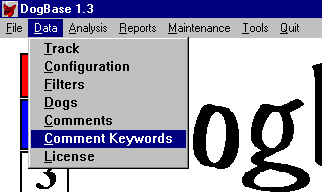
Taking the Comment Keywords option will display a screen similar to the following.
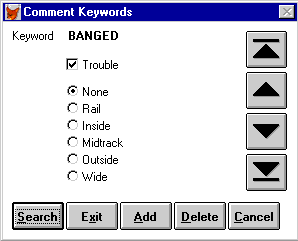
Trouble should be checked if the word implies trouble.
The where runs fields should be checked if the word is implying a track position for running.
For the most part you should not have to do any changes to this area. The file sent with DogBase was built from a huge database and should contain most all the words that would indicate trouble or where runs.
New optional features are going to become available over time and you will need to be able to see and change your license data for DogBase to take advantage of these options. This menu gives you the ability to see your license data as well as type in license information for optional features. When you select the license option from the Data pull down menu in DogBase a window similar to the following will be displayed.
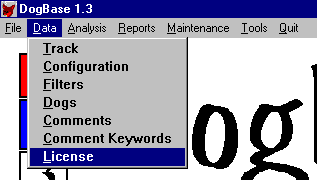
As of the writing of this document the only optional feature is the Export Data. This is provided to those who would like to take data that is stored in DogBase and output it to a file format used by many other software packages.
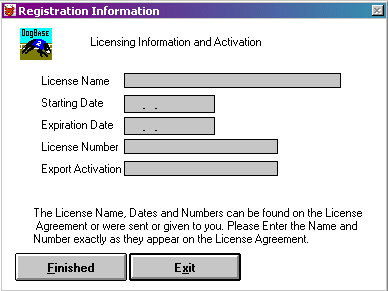
You may either select the Exit button to not make any changes or type your changes and press the Finished key.
Remember changes to the License Name, License number or the Export Activation must be typed exactly as they were provided to you by DogBase, Inc. or the program and / or features may not work properly.
Return to the DogBase 1.3 Manual - Table of Contents
Copyright © 1998 DogBase, Inc. All Rights Reserved.
Last Updated 03/05/98